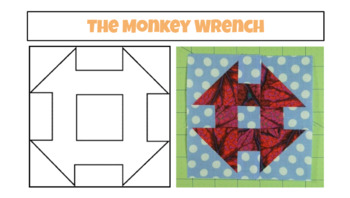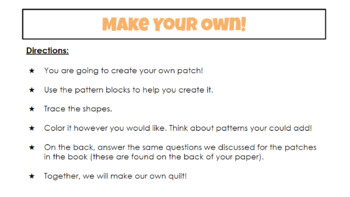The Patchwork Path: Shape Classification Introduction
Barefoot Teachin'
14 Followers
Grade Levels
3rd - 8th
Subjects
Resource Type
Standards
CCSS3.G.A.1
CCSS4.G.A.1
CCSS4.G.A.2
CCSS5.G.B.3
CCSS5.G.B.4
Formats Included
- Google Slides™
Pages
26 pages
Barefoot Teachin'
14 Followers

Made for Google Drive™
This resource can be used by students on Google Drive or Google Classroom. To access this resource, you’ll need to allow TPT to add it to your Google Drive. See our FAQ and Privacy Policy for more information.
Description
This lesson is a great opener or introduction lesson for classifying 2-dimensional shapes and integrates literacy into mathematics.
Students will review and discuss important vocabulary related to shapes including: perpendicular lines, parallel lines, acute angles, right angles, obtuse angles, and more.
Students will read, "The Patchwork Path: A Quilt Map to Freedom" and then identify shapes, lines, and angles they see in the patches.
At the end, students will have an opportunity to create their own patch.
Total Pages
26 pages
Answer Key
N/A
Teaching Duration
90 minutes
Report this resource to TPT
Reported resources will be reviewed by our team. Report this resource to let us know if this resource violates TPT’s content guidelines.
Standards
to see state-specific standards (only available in the US).
CCSS3.G.A.1
Understand that shapes in different categories (e.g., rhombuses, rectangles, and others) may share attributes (e.g., having four sides), and that the shared attributes can define a larger category (e.g., quadrilaterals). Recognize rhombuses, rectangles, and squares as examples of quadrilaterals, and draw examples of quadrilaterals that do not belong to any of these subcategories.
CCSS4.G.A.1
Draw points, lines, line segments, rays, angles (right, acute, obtuse), and perpendicular and parallel lines. Identify these in two-dimensional figures.
CCSS4.G.A.2
Classify two-dimensional figures based on the presence or absence of parallel or perpendicular lines, or the presence or absence of angles of a specified size. Recognize right triangles as a category, and identify right triangles.
CCSS5.G.B.3
Understand that attributes belonging to a category of two-dimensional figures also belong to all subcategories of that category. For example, all rectangles have four right angles and squares are rectangles, so all squares have four right angles.
CCSS5.G.B.4
Classify two-dimensional figures in a hierarchy based on properties.





